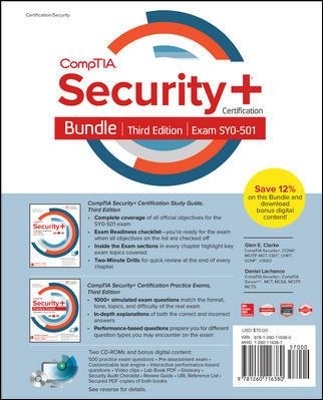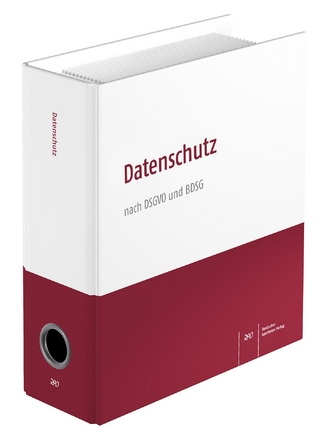
CompTIA Security+ Certification Bundle, Third Edition (Exam SY0-501)
McGraw-Hill Education
978-1-260-11638-0 (ISBN)
- Titel erscheint in neuer Auflage
- Artikel merken
This up-to-date test preparation bundle covers every objective on the latest version of the CompTIA Security+ exam. Designed to be the ultimate self-study resource, the bundle includes the current editions of CompTIA Security+ Certification Study Guide and CompTIA Security+ Certification Practice Exams and exclusive electronic content—all at a discount of 12% off of the suggested retail price.
CompTIA Security+ Certification Bundle, Third Edition, provides examinees with a wide variety of exam-focused preparation resources. Bonus content includes a quick review guide, a security audit checklist, and a URL reference list. Electronic content from the two books features author-led video training, lab simulations, and customizable test engine software that contains four complete practice exams.
• 12% cheaper than purchasing the books individually, and features content unavailable elsewhere
• Includes a 10% off exam voucher coupon, a $37 value
• CompTIA Approved Quality Content (CAQC)—provides complete coverage of every objective on exam SY0-501
Glen E. Clarke, CCNA, MCITP, CEH, CHFI, SCNP, CISSO, CompTIA Security+, CompTIA Network+, CompTIA A+, is an independent trainer and consultant. He has authored many certification books, including CompTIA Network+ Certification Study Guide, Fifth Edition. Daniel Lachance, CompTIA Security+, CompTIA A+, CompTIA Network+ MCITP, MCTS, MCSA, is a technical trainer for Global Knowledge and the author of CompTIA Cloud Essentials Certification Study Guide.
Section I: “How to Access the Bonus Content”
Section II: CompTIA Security+ Certification Study Guide, Third Edition (Exam SY0-501)
Cover
Title Page
Copyright Page
Dedication
About the Author
Contents at a Glance
Contents
Preface
Acknowledgments
Introduction
Exam Readiness Checklist
1 Networking Basics and Terminology
Understanding Network Devices and Cabling
Looking at Network Devices
Understanding Network Cabling
Exercise 1-1: Reviewing Networking Components
Understanding TCP/IP
Reviewing IP Addressing
Exercise 1-2: Understanding Valid Addresses
Understanding TCP/IP Protocols
Exercise 1-3: Viewing Protocol Information with Network Monitor
Understanding Application Layer Protocols
Understanding IPv6
Exercise 1-4: Identifying Protocols in TCP/IP
Network Security Best Practices
Device Usage
Cable and Protocol Usage
Certification Summary
✓ Two-Minute Drill
Q&A Self Test
Self Test Answers
2 Introduction to Security Terminology
Goals of Information Security
Confidentiality
Integrity
Availability
Accountability
Exercise 2-1: CIA Scenarios
Understanding Authentication and Authorization
Identification and Authentication
Authorization
Understanding Security Principles and Terminology
Types of Security
Least Privilege, Separation of Duties, and Rotation of Duties
Concept of Need to Know
Layered Security and Diversity of Defense
Due Care and Due Diligence
Vulnerability and Exploit
Threat Actors
Looking at Security Roles
System Owner and Data Owner
System Administrator
User
Privileged User
Executive User
Data Roles
Security Officer
Exercise 2-2: Security Terminology
Certification Summary
✓ Two-Minute Drill
Q&A Self Test
Self Test Answers
3 Security Policies and Standards
Introduction to Security Policies
Structure of a Policy
Identifying Types of Policies
Understanding Regulations and Standards
General Security Policies
Policies Affecting Users
Policies Affecting Personnel Management
Policies Affecting Administrators
Exercise 3-1: Reviewing a Security Policy
Policies Affecting Management
Other Popular Policies
Human Resources Policies
Hiring Policy
Termination Policy
Mandatory Vacations
Security-Related HR Policies
Exercise 3-2: Creating a Security Policy
User Education and Awareness
General Training and Role-Based Training
User Habits
New Threats and Security Trends
Use of Social Networks and P2P Programs
Training Metrics and Follow-Up
Exercise 3-3: Designing a Training Program
Certification Summary
✓ Two-Minute Drill
Q&A Self Test
Self Test Answers
4 Types of Attacks
Understanding Social Engineering
Social Engineering Overview
Popular Social Engineering Attacks
Reasons for Effectiveness
Preventing Social Engineering Attacks
Identifying Network Attacks
Popular Network Attacks
Exercise 4-1: DNS Poisoning After Exploit Using Kali Linux
Exercise 4-2: Performing a Port Scan
Other Network Attacks
Preventing Network Attacks
Looking at Password Attacks
Types of Password Attacks
Exercise 4-3: Password Cracking with LC4
Birthday Attacks, Rainbow Tables, and Known-Plaintext Attacks
Online vs. Offline Attacks
Other Password Attack Terms
Preventing Password Attacks
Understanding Application Attacks
Popular Application Attacks
Exercise 4-4: SQL Injection Attacks
Exercise 4-5: Exploiting an IIS Web Server with Folder Traversal
Other Application Attacks
Preventing Application Attacks
Certification Summary
✓ Two-Minute Drill
Q&A Self Test
Self Test Answers
5 System Security Threats
Identifying Physical Threats
Snooping
Theft and Loss of Assets
Human Error
Sabotage
Looking at Malicious Software
Privilege Escalation
Viruses
Exercise 5-1: Looking at the NetBus Trojan Virus
Other Malicious Software
Protecting Against Malicious Software
Threats Against Hardware
BIOS Settings
USB Devices
Smart Phones and Tablets
Exercise 5-2: Exploiting a Bluetooth Device
Removable Storage
Network Attached Storage
PBX
Certification Summary
✓ Two-Minute Drill
Q&A Self Test
Self Test Answers
6 Mitigating Security Threats
Understanding Operating System Hardening
Uninstall Unnecessary Software
Disable Unnecessary Services
Exercise 6-1: Disabling the Remote Desktop Services Service
Protect Management Interfaces and Applications
Disable Unnecessary Accounts
Patch System
Password Protection
System Hardening Procedures
Network Security Hardening
Exercise 6-2: Hardening a Network Switch
Tools for System Hardening
Exercise 6-3: Creating a Security Template
Security Posture and Reporting
Establishing Application Security
Secure Coding Concepts
Secure Coding Techniques
Application Hardening
Server Hardening Best Practices
All Servers
HTTP Servers
DNS Servers
Exercise 6-4: Limiting DNS Zone Transfers
DHCP Servers
SMTP Servers and FTP Servers
Mitigate Risks in Static Environments
Common Security Issues and Device Output
Troubleshooting Common Security Issues
Analyzing and Interpreting Output from Security Technologies
Exercise 6-5: Removable Media Control
Frameworks and Security Guides
Certification Summary
✓ Two-Minute Drill
Q&A Self Test
Self Test Answers
7 Implementing System Security
Implementing Host-Based Firewalls and HIDS
Host-Based Firewalls
Exercise 7-1: Configuring TCP Wrappers in Linux
Host-Based IDS and Host-Based IPS
Protecting Against Malware
Patch Management
Using Antivirus and Anti-spam Software
Spyware and Adware
Phish Filters and Pop-up Blockers
Exercise 7-2: Manually Testing a Web Site for Phishing
Practicing Good Habits
Device Security and Data Security
Hardware Security
Mobile Devices
Data Security
Exercise 7-3: Configuring Permissions in Windows 8
Application Security and BYOD Concerns
Secure System Design
Secure Staging Deployment
Understanding Virtualization and Cloud Computing
Virtualization and Security
Cloud Computing Overview
Cloud Computing Considerations
Resiliency and Automation
Certification Summary
✓ Two-Minute Drill
Q&A Self Test
Self Test Answers
8 Securing the Network Infrastructure
Understanding Firewalls
Firewalls
Using IPTables as a Firewall
Exercise 8-1: Configuring IPTables in Linux
Using Firewall Features on a Home Router
NAT and Ad Hoc Networking
Proxy Servers
Routers and ACLs
Other Security Devices and Technologies
Using Intrusion Detection Systems
IDS Overview
Exercise 8-2: Using Snort: A Network-Based IDS
Honeypots and Honeynets
Protocol Analyzers
Network Design and Administration Principles
Subnetting and VLANs
Network Switches
Network Address Translation (NAT)
Network Access Control (NAC)
Data Loss Prevention (DLP)
Mail Gateway
Network Communication Encryption
Network Administration Principles
Security Device Placement
Securing Devices
Certification Summary
✓ Two-Minute Drill
Q&A Self Test
Self Test Answers
9 Wireless Networking and Security
Understanding Wireless Networking
Standards
Channels
Antenna Types
Authentication and Encryption
Securing a Wireless Network
Security Best Practices
Vulnerabilities with Wireless Networks
Exercise 9-1: Cracking WEP with Kali Linux
Perform a Site Survey
Configuring a Wireless Network
Configuring the Access Point
Configuring the Client
Other Wireless Technologies
Infrared
Bluetooth
Near Field Communication
RFID
Certification Summary
✓ Two-Minute Drill
Q&A Self Test
Self Test Answers
10 Authentication
Identifying Authentication Models
Authentication Terminology
Authentication Factors
Single Sign-on
Authentication Protocols
Windows Authentication Protocols
Remote Access Authentication
Authentication Services
Implementing Authentication
User Accounts
Tokens
Looking at Biometrics
Certificate-Based Authentication
Claims-Based Authentication/Federation Services
Certification Summary
✓ Two-Minute Drill
Q&A Self Test
Self Test Answers
11 Access Control
Introducing Access Control
Types of Security Controls
Implicit Deny
Review of Security Principles/General Concepts
Access Control Models
Discretionary Access Control
Mandatory Access Control
Role-Based Access Control
Exercise 11-1: Assigning a User the sysadmin Role
Rule-Based Access Control
Group-Based Access Control
Attribute-Based Access Control
Implementing Access Control
User Account Types
Using Security Groups
Exercise 11-2: Configuring Security Groups and Assigning Permissions
Rights and Privileges
Exercise 11-3: Modifying User Rights on a Windows System
File System Security and Printer Security
Access Control Lists (ACLs)
Group Policies
Exercise 11-4: Configuring Password Policies via Group Policies
Database Security
Exercise 11-5: Encrypting Sensitive Information in the Database
Account Restrictions
Account Policy Enforcement
Monitoring Account Access
Certification Summary
✓ Two-Minute Drill
Q&A Self Test
Self Test Answers
12 Introduction to Cryptography
Introduction to Cryptography Services
Understanding Cryptography
Algorithms and Keys
Exercise 12-1: Encrypting Data with the Caesar Cipher
Other Cryptography Terms
Symmetric Encryption
Symmetric Encryption Concepts
Symmetric Encryption Algorithms
Exercise 12-2: Encrypting Data with the AES Algorithm
Asymmetric Encryption
Asymmetric Encryption Concepts
Asymmetric Encryption Algorithms
Quantum Cryptography
In-Band vs. Out-of-Band Key Exchange
Understanding Hashing
Hashing Concepts
Hashing Algorithms
Exercise 12-3: Generating Hashes to Verify Integrity
Identifying Encryption Uses
Common Use Cases
Encrypting Data
Encrypting Communication
Understanding Steganography
Certification Summary
✓ Two-Minute Drill
Q&A Self Test
Self Test Answers
13 Managing a Public Key Infrastructure
Introduction to Public Key Infrastructure
Understanding PKI Terminology
Certificate Authority and Registration Authority
Repository
Managing a Public Key Infrastructure
Certificate Life Cycle
Certificate Revocation Lists and OCSP
Other PKI Terms
Implementing a Public Key Infrastructure
How SSL/TLS Works
How Digital Signatures Work
Creating a PKI
Exercise 13-1: Installing a Certificate Authority
Exercise 13-2: SSL-Enabling a Web Site
Managing a PKI
Certification Summary
✓ Two-Minute Drill
Q&A Self Test
Self Test Answers
14 Physical Security
Choosing a Business Location
Facility Concerns
Lighting and Windows
Doors, Windows, and Walls
Safety Concerns
Physical Access Controls
Exercise 14-1: Erasing the Administrator Password with a Live DVD
Fencing and Guards
Hardware Locks/Lock Types
Access Systems
Other Security Controls
Physical Access Lists and Logs
Video Surveillance
Implementing Environmental Controls
Understanding HVAC
Shielding
Fire Suppression
Certification Summary
✓ Two-Minute Drill
Q&A Self Test
Self Test Answers
15 Risk Analysis
Introduction to Risk Analysis
Risk Analysis Overview
Risk Analysis Process
Risk with Cloud Computing and Third Parties
Types of Risk Analysis
Qualitative
Exercise 15-1: Performing a Qualitative Risk Analysis
Quantitative
Exercise 15-2: Performing a Quantitative Risk Analysis
Risk Mitigation Strategies
Exercise 15-3: Identifying Mitigation Techniques
Certification Summary
✓ Two-Minute Drill
Q&A Self Test
Self Test Answers
16 Disaster Recovery and Business Continuity
Introduction to Disaster Recovery and Business Continuity
Introduction to Business Continuity
Understanding Disaster Recovery
Backing Up and Restoring Data (Backup Concepts)
Security Considerations with Tapes
Full, Incremental, and Differential Backups
Scheduling Backups
Backup Plan Example
Exercise 16-1: Backing Up and Restoring Data on a Windows Server
Geographic Considerations
Implementing Fault Tolerance
RAID 0
RAID 1
RAID 5
Understanding High Availability
Failover Clustering
Network Load Balancing
Redundant Hardware
Certification Summary
✓ Two-Minute Drill
Q&A Self Test
Self Test Answers
17 Introduction to Computer Forensics and Incident Response
Working with Evidence
Types of Evidence
Collecting Evidence
Collecting Digital Evidence
Understanding the Process
Where to Find Evidence
Tools Used
Exercise 17-1: Using ProDiscover Basic for Forensics Analysis
Exercise 17-2: Performing Cell Phone Forensics
Exercise 17-3: Looking at Exif Metadata
Looking at Incident Response
Incident Response Team
Incident Response Plan
Incident Response Process
First Responders
Damage and Loss Control
Certification Summary
✓ Two-Minute Drill
Q&A Self Test
Self Test Answers
18 Security Assessments and Audits
Understanding Types of Assessments
Assessment Types
Assessment Techniques
Performing a Security Assessment
Performing a Penetration Test
Exercise 18-1: Profiling an Organization
Exercise 18-2: Using a Port Scanner
Performing a Vulnerability Assessment
Exercise 18-3: Performing a Vulnerability Scan with MBSA
Certification Summary
✓ Two-Minute Drill
Q&A Self Test
Self Test Answers
19 Understanding Monitoring and Auditing
Introduction to Monitoring
Monitoring Tools
Useful System Commands
SNMP
Performance Monitor
Protocol Analyzer and Sniffer
Exercise 19-1: Monitoring Network Traffic with Network Monitor
Security Information and Event Management (SIEM)
Implementing Logging and Auditing
Understanding Auditing
Exercise 19-2: Implementing Auditing in Windows
Understanding Logging
Exercise 19-3: Configuring Logging in IIS
Exercise 19-4: Configuring Windows Firewall
Popular Areas to Audit
Certification Summary
✓ Two-Minute Drill
Q&A Self Test
Self Test Answers
A About the Download
System Requirements
Total Tester Premium Practice Exam Software
Installing and Running Total Tester
Pre-assessment Test
McGraw-Hill Professional Media Center Download
Performance-Based Question Simulations
Video Training from the Author
Pre-assessment Exam in Total Tester: Analyzing Your Results
Glossary
Lab Book, Lab Solutions, and Lab Files
Technical Support
Total Seminars Technical Support
McGraw-Hill Education Content Support
Index
Section III: CompTIA Security+ Certification Practice Exams, Third Edition (Exam SY0-501)
Cover
Title Page
Copyright Page
Dedication
About the Authors
About the Technical Editor
Contents at a Glance
Contents
Acknowledgments
Introduction
Exam Readiness Checklist
1 Networking Basics and Terminology
Questions
Quick Answer Key
In-Depth Answers
2 Introduction to Security Terminology
Questions
Quick Answer Key
In-Depth Answers
3 Security Policies and Standards
Questions
Quick Answer Key
In-Depth Answers
4 Types of Attacks
Questions
Quick Answer Key
In-Depth Answers
5 System Security Threats
Questions
Quick Answer Key
In-Depth Answers
6 Mitigating Security Threats
Questions
Quick Answer Key
In-Depth Answers
7 Implementing System Security
Questions
Quick Answer Key
In-Depth Answers
8 Securing the Network Infrastructure
Questions
Quick Answer Key
In-Depth Answers
9 Wireless Networking and Security
Questions
Quick Answer Key
In-Depth Answers
10 Authentication
Questions
Quick Answer Key
In-Depth Answers
11 Access Control
Questions
Quick Answer Key
In-Depth Answers
12 Introduction to Cryptography
Questions
Quick Answer Key
In-Depth Answers
13 Managing a Public Key Infrastructure
Questions
Quick Answer Key
In-Depth Answers
14 Physical Security
Questions
Quick Answer Key
In-Depth Answers
15 Risk Analysis
Questions
Quick Answer Key
In-Depth Answers
16 Disaster Recovery and Business Continuity
Questions
Quick Answer Key
In-Depth Answers
17 Introduction to Computer Forensics and Incident Response
Questions
Quick Answer Key
In-Depth Answers
18 Security Assessments and Audits
Questions
Quick Answer Key
In-Depth Answers
19 Understanding Monitoring and Auditing
Questions
Quick Answer Key
In-Depth Answers
A Pre-assessment Exam
Questions
Quick Answer Key
In-Depth Answers
B About the CD-ROM
System Requirements
Installing and Running Total Tester Premium Practice Exam Software
Total Tester Premium Practice Exam Software
Performance-Based Questions
Secured Book PDF
Technical Support
| Erscheint lt. Verlag | 26.12.2017 |
|---|---|
| Verlagsort | OH |
| Sprache | englisch |
| Maße | 185 x 231 mm |
| Gewicht | 2055 g |
| Themenwelt | Informatik ► Netzwerke ► Sicherheit / Firewall |
| Informatik ► Weitere Themen ► Zertifizierung | |
| ISBN-10 | 1-260-11638-7 / 1260116387 |
| ISBN-13 | 978-1-260-11638-0 / 9781260116380 |
| Zustand | Neuware |
| Haben Sie eine Frage zum Produkt? |
aus dem Bereich



